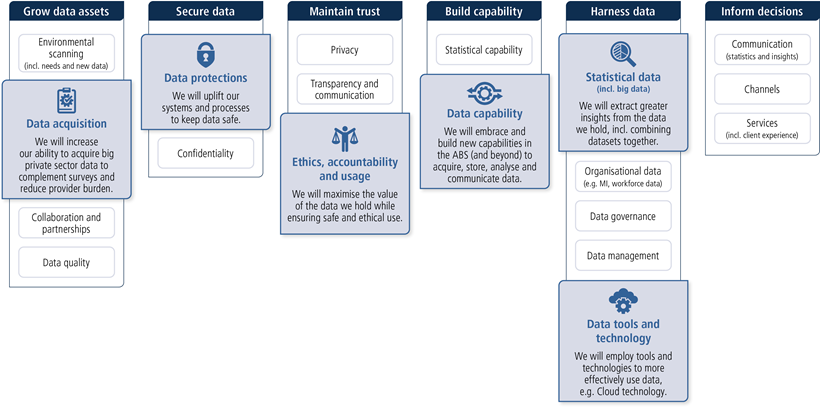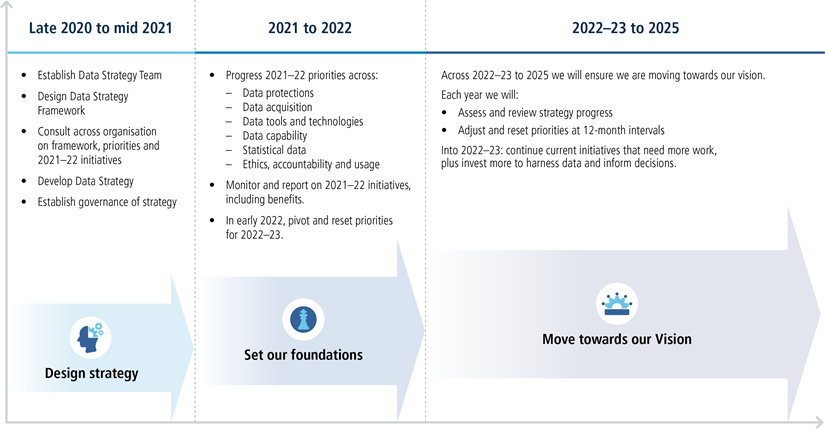ABS Data Strategy 2021-22 to 2025
Purpose and scope
A dedicated data strategy that is long term, action focused and helps to guide ABS business to deliver public value, will help the ABS fulfil its purpose:
To inform Australia’s important decisions by delivering relevant, trusted and objective data, statistics and insights.
✔ What this strategy is
With consultation across the ABS, this strategy was designed as an overarching approach to support the organisation to maximise the value of data. This strategy:
- Sets out the ABS vision to maximise the value of data across the organisation and lead in big data use
- Defines principles and objectives to achieve this vision
- Explains why the priority components are important and how they help us get closer to our vision
- Identifies initiatives for action under the strategy
- Creates accountability for progress by setting out governance and measures for success.
❌ What this strategy is not
This strategy is one of the ABS’ enabling strategies that supports the overall ABS purpose. This strategy supports the Enterprise Strategy and sits alongside other enabling strategies however:
- This is not a whole of government nor a whole of Australian Public Service (APS) data strategy
- This is not an enterprise or business strategy or a Corporate Plan
- This is not an information management strategy
- This is not an ICT strategy to advance digitalisation of our processes and services, but it recognises that technology is fundamental to maximising the value of data
- This is not a people capability or workforce strategy, but it recognises that generating value from data involves everyone.
Context
Data have always been a core part of ABS operations, however over the last decade Government entities have recognised that making better use of their data can improve their ability to develop public policy, deliver services, and address complex challenges.
There has also been an enormous increase in data held by the ABS. Technological advances have increased our capacity to acquire, process, store and provide access to data. At the same time, public and business expectations of government have changed. The volume of data available, and the ease with which anyone can produce and disseminate false information, have increased concerns about privacy, and generally reduced trust in institutions.
In recognition of this, a range of activities across the APS and the ABS aim to maximise the value of public sector data, while meeting community expectations. The diagram below provides a snapshot of some key APS and ABS data activities over the last 15 years.
Image

Description
Opportunities ahead
Looking at the ABS operating context out to 2025, the strategy reflects the changing nature of our business and identifies a range of drivers and opportunities that affect our use of data in our day-to-day work.
| The drivers | The opportunities | |
|---|---|---|
| Some siloed data assets – Some of our existing data assets are division or subject-matter specific | ➤ | We maximise use of data across the ABS – e.g. big data is collected once and used by many subject matter areas |
| Keeping pace with security and protections – We need to continue to keep data safe and meet the expectations of our data providers | ➤ | Modern data protections enable us to work with new data sources, and collect direct from providers reducing burden |
| Need for clear direction – We need a strategic organisational approach to leverage maximum value from our data | ➤ | We maximise value from our own data and data shared with us from other organisations (through greater reuse and integration) |
| New expectations of trust – Public expectations and awareness around use of data continue to evolve. | ➤ | We grow our role as a leader in use of data for public good. |
Vision statement
‘By 2025, we maximise the value of data across our organisation, and lead in big data use, to deliver relevant, trusted and objective official statistics, insights and data services.’
We do this to help us fulfil the ABS Purpose
The ABS’ purpose is to inform Australia’s important decisions by delivering relevant, trusted and objective data, statistics and insights.
We tell the real story of Australia, its economy and its people by bringing life and meaning to numbers. We are committed to pushing the boundaries of what data can do for Australian communities, businesses and Governments.
What this means
✔ Our vision statement defines our ambition: to maximise the value of data internally to deliver value externally
✔ A clear direction to focus on big data and to lead in its use
✔ It is not about data for its own sake, but to help us to deliver official statistics, insights and data services and fulfil our purpose
✔ This strategy outlines how we can move closer to this vision, by outlining priority areas for 2021–22 and a framework to move us toward 2025.
Six principles to guide data action in the ABS
| Principle | Why is it important | |
|---|---|---|
| 1 | Data is viewed and used as an organisational asset | Improves our flexibility to respond to changing information needs. This also pushes us to reuse data across the ABS. |
| 2 | Data is open, accessible and discoverable by default | Enables us to maximise use and re-use of data across the entire organisation. |
| 3 | Protection and privacy proportionate to value and risk | We protect and manage risks for data assets based on their value to maintain public trust. |
| 4 | We embrace and grow new data capabilities | We recognise data capabilities are changing and will continue to uplift our data capabilities. |
| 5 | We value data from various sources, and it is effortless to share data with us | We value big public and private sector data sources and surveys and want to ensure our governance processes are streamlined to support data sharing between us and our partners. This encompasses minimising provider burden. |
| 6 | We are innovative leaders in the Australian data landscape | As Australia’s National Statistics Office we want to be at the forefront of innovation in the Australian data landscape. |
Strategic framework
Image

Description
Strategic priorities for 2021–22
The following components were identified during consultations as strategic priorities for 2021–22 and were endorsed by the ABS Executive Board. These components are mutually reinforcing and will help us set our foundations to maximise use of data to deliver greater public value. Data Strategy priorities will be re-assessed annually and other components will be a focus in future years.
Image

Description
Timeline for the Data Strategy
The first year of the ABS Data Strategy over 2021–22 will set our foundations and progress across priority areas. The Data Strategy will be reviewed and adjusted each year as we move towards our vision.
Image

Description
ABS Enterprise Planning Framework
The ABS Data Strategy is an enabling strategy in the broader ABS Enterprise Planning Framework.